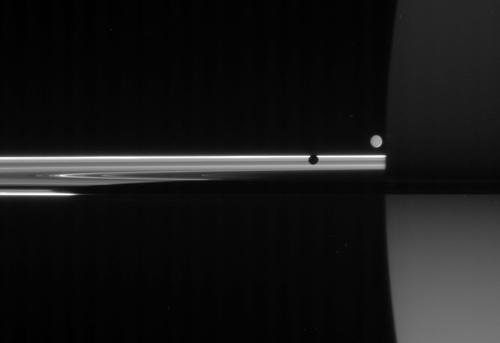Friday, July 14, 2006
Contrasts at Saturn: Catching Up
The Voyager probes sent back sublime images of formerly hidden details. The enormous advantage of the Cassini probe is that it's an orbiter. It's able to return again and again to view the planet, rings, and moon, permitting scientists to study them all from various perspectives. Some good images this week from Cassini.
Images like this first one below are fascinating:
- Part of the ring is in shadow, but on the sunlit portion, you can see the banding.
- The night side of Saturn south of the rings is gently lit by sunlight reflected off the rings--far more of an effect than the full moon lighting an Earth evening. If you were flying in Saturn's cloud tops, you'd see a great arch in the sky seemingly with one end having been bit off (that would be the planet's shadow). Interesting mythologies would develop from that one, I'm sure, especially since the bit off end would probably appear red-brown. If Saturnians had red blood, they'd assume the ring was bleeding.
- Don't forget the moons: Mimas is that black sphere, and Enceladus is in the light
 See the little speck on the edge of darkness just below Saturn's rings? That's Epimetheus, one of Saturn's tiny shepherd moons. Almost insignificant compared to the great bulk of the father planet, but Epi and its companions are responsible for maintaining the ring within fairly distinct boundaries.
See the little speck on the edge of darkness just below Saturn's rings? That's Epimetheus, one of Saturn's tiny shepherd moons. Almost insignificant compared to the great bulk of the father planet, but Epi and its companions are responsible for maintaining the ring within fairly distinct boundaries.
 The back-lit views of Titan are possible because of this year's tweaking of Cassini's orbit. Scientists wanted multiple experiences of recording sunlight through Titan's atmosphere and Saturn's rings. Not only that, but passing radio signals through these on their way to the Earth gives further insight as to the make-up and structure of that orange air and dense ring particles.
Below, the contrast of airless Rhea and Titan's thick nitrogen-hydrocarbon atmosphere.
The back-lit views of Titan are possible because of this year's tweaking of Cassini's orbit. Scientists wanted multiple experiences of recording sunlight through Titan's atmosphere and Saturn's rings. Not only that, but passing radio signals through these on their way to the Earth gives further insight as to the make-up and structure of that orange air and dense ring particles.
Below, the contrast of airless Rhea and Titan's thick nitrogen-hydrocarbon atmosphere.

 See the little speck on the edge of darkness just below Saturn's rings? That's Epimetheus, one of Saturn's tiny shepherd moons. Almost insignificant compared to the great bulk of the father planet, but Epi and its companions are responsible for maintaining the ring within fairly distinct boundaries.
See the little speck on the edge of darkness just below Saturn's rings? That's Epimetheus, one of Saturn's tiny shepherd moons. Almost insignificant compared to the great bulk of the father planet, but Epi and its companions are responsible for maintaining the ring within fairly distinct boundaries.
 The back-lit views of Titan are possible because of this year's tweaking of Cassini's orbit. Scientists wanted multiple experiences of recording sunlight through Titan's atmosphere and Saturn's rings. Not only that, but passing radio signals through these on their way to the Earth gives further insight as to the make-up and structure of that orange air and dense ring particles.
Below, the contrast of airless Rhea and Titan's thick nitrogen-hydrocarbon atmosphere.
The back-lit views of Titan are possible because of this year's tweaking of Cassini's orbit. Scientists wanted multiple experiences of recording sunlight through Titan's atmosphere and Saturn's rings. Not only that, but passing radio signals through these on their way to the Earth gives further insight as to the make-up and structure of that orange air and dense ring particles.
Below, the contrast of airless Rhea and Titan's thick nitrogen-hydrocarbon atmosphere.
